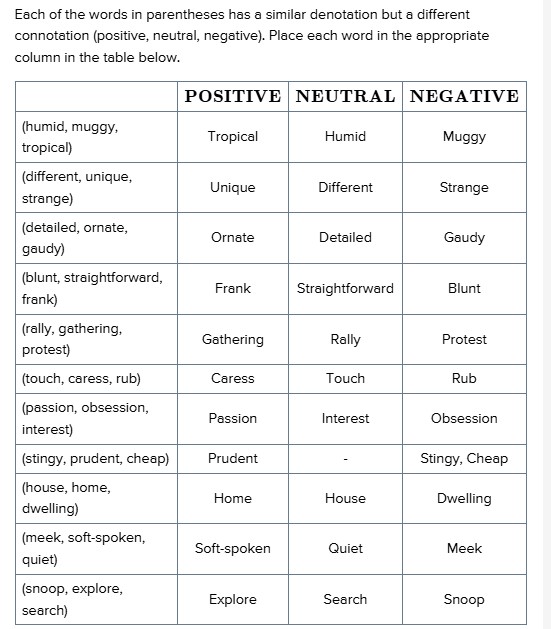QQuestionAnatomy and Physiology
QuestionAnatomy and Physiology
Each of the words in parentheses has a similar denotation but a different connotation (positive, neutral, negative). Place each word in the appropriate column in the table below.
| | POSITIVE | NEUTRAL | NEGATIVE |
| --- | --- | --- | --- |
| (humid, muggy,
tropical) | Tropical | Humid | Muggy |
| (different, unique,
strange) | Unique | Different | Strange |
| (detailed, ornate,
gaudy) | Ornate | Detailed | Gaudy |
| (blunt, straightforward,
frank) | Frank | Straightforward | Blunt |
| (rally, gathering,
protest) | Gathering | Rally | Protest |
| (touch, caress, rub) | Caress | Touch | Rub |
| (passion, obsession,
interest) | Passion | Interest | Obsession |
| (stingy, prudent, cheap) | Prudent | - | Stingy, Cheap |
| (house, home,
dwelling) | Home | House | Dwelling |
| (meek, soft-spoken,
quiet) | Soft-spoken | Quiet | Meek |
| (snoop, explore,
search) | Explore | Search | Snoop |
Attachments

6 months agoReport content
Answer
Full Solution Locked
Sign in to view the complete step-by-step solution and unlock all study resources.
Step 1I'll solve this problem by carefully analyzing the connotations of each word group.
Step 2: Understanding Connotations
Connotations refer to the emotional or cultural associations of words beyond their literal meaning: - Positive connotation: Words with favorable or pleasant implications - Neutral connotation: Words that are objective and factual - Negative connotation: Words with unfavorable or unpleasant implications
Final Answer
The table above shows each word categorized by its connotative meaning, distinguishing between positive, neutral, and negative emotional implications.
Need Help with Homework?
Stuck on a difficult problem? We've got you covered:
- Post your question or upload an image
- Get instant step-by-step solutions
- Learn from our AI and community of students